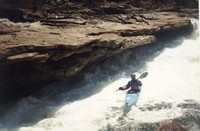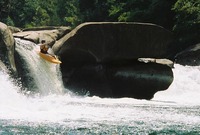Undercut Rocks
Undercuts can be very dangerous as we will discuss in this article. Undercut rock formations are often quite irregular and may capture river debris like trees, branches, and manmade objects. Either way if you are in your boat or out of your boat, passing through an undercut rock is a crap shoot. Seldom can you see under the water surface and what you don't see can be very deadly indeed. Since undercuts are typically in rapids the force of water can be really strong as well. Undercut rocks are created where the water is most forceful like the outside of bends, waterfalls and high ledges, and sometimes in mid-current like the clam shell formation on Railroad Rapid on the New River Gorge.
Rescuing a paddler trapped in an undercut is very challenging as well. If you are lucky, you can get a rope to the victim while they are still upright. Even in those situations, you will often need to pull them back out against the same fast moving water they swept them there in the first place. Sometimes vertical rescue techniques are required and they take considerable time to safely set up.
The best way to avoid these hazards is to research your planned run in guide books and the AW River Database. Another good source is asking paddlers that have been down this run before. Many undercuts provide some clues if you scout from shore, walk to the end of the rapid, and look back upstream. If you have a large boulder and water isn't pillowing on the upstream side as well as a very weak eddy on the downstream side - stay away! This is a tell tale undercut formation. There isn't any water pressure forming the pillow because the water is leaking out from underneath.
 When running streams that have a sharp rock wall bend, angle your boat away from the wall. Water over time will undercut the rock wall, See example on the right. Once again if the wall is undercut, water is less likely to rise against the wall since it can escape underneath.
When running streams that have a sharp rock wall bend, angle your boat away from the wall. Water over time will undercut the rock wall, See example on the right. Once again if the wall is undercut, water is less likely to rise against the wall since it can escape underneath.
 Waterfalls often form a double boil line at their curtain. The backside of the curtain gets carved away overtime forming an undercut. Notice how this waterfall is carved out on the kayakers right side. Rescues from this position are also quite tricky since it is hard to get a rope to the victim.
Waterfalls often form a double boil line at their curtain. The backside of the curtain gets carved away overtime forming an undercut. Notice how this waterfall is carved out on the kayakers right side. Rescues from this position are also quite tricky since it is hard to get a rope to the victim.
We will demonstrate a very deceptive undercut rock at the bottom of the Z Channel rapid using a throw rope.
Ice
Ice can form another type of undercut in the form of an ice shelf. Natural rivers rise and fall all the time. This can form air pockets underneath the ice shelf. Now add some fast current and you have the making of a mega-strainer. If you get swept underneath, you will find it very difficult to break your way through the ice ceiling. Large ice flows also act like big battering rams. Imagine having an ice sheet smack your rib cage. You also need to consider that we often paddle in remote locations and getting help in time isn't very likely. Winter paddling can be a great deal of fun but I stay off streams with lots of ice - it just isn't worth the risk. Here is an excellent video on the dangers of ice and rescue options: Dangers of Ice
